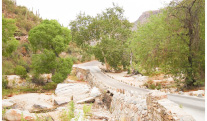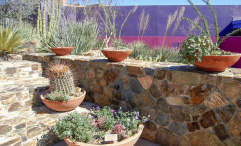By Jessica Atha
Tucson is the second-largest city in Arizona, home of the University of Arizona and Davis-Monthan Air Force Base. Approximately 67 million years ago, this desert valley was a tropical rainforest. Today, it is one of the most beautiful desert landscapes in the world, framed on two sides by the majestic Catalina and Rincon  Mountains. Its spectacular scenery combined with the mild winters make Tucson a popular destination for vacationers. One of Tucson’s advantages over other hot-climate destinations is the low humidity. The locals have heard it a million times—“It’s a dry heat.” And it’s true. The air is light and clean for easy, breezy breathing. But dry air doesn’t mean dry fun. We love our water here in Tucson, and we always make the most of it.
Mountains. Its spectacular scenery combined with the mild winters make Tucson a popular destination for vacationers. One of Tucson’s advantages over other hot-climate destinations is the low humidity. The locals have heard it a million times—“It’s a dry heat.” And it’s true. The air is light and clean for easy, breezy breathing. But dry air doesn’t mean dry fun. We love our water here in Tucson, and we always make the most of it.
4th Avenue
Higher education is part of the attraction for those who settle in Tucson. The University of Arizona is full of vibrant college culture and it’s a pleasure to visit, student or not. You can arrange to ride in one of the University Pedi-cabs—hybrid electric bicycles that hold up to three people. Pedi-cabs are completely emissions-free and a fabulous way to tour the campus or travel through the nearby historic 4th Avenue shopping district. With all of its shops, restaurants, and bars, 4th Avenue is one of the hottest spots in town.
If you’re like me and you enjoy reading on your vacation, check out the 100 percent solar-powered Antigone Bookstore, 411 N. 4th Ave., voted best independent bookstore by Tucson Weekly. If you prefer non-fiction, Antigone specializes in feminist authors and subjects. When you’re feeling peckish from riding in your pedi-cab, drop in to the Brooklyn Pizza Company, 534 N. 4th Ave., for some delicious vegetarian options and refreshing Italian ice or gelato. It’s completely solar-powered—you can check out the cool solar output statistics on their website. They also save 80,000 gallons of water and 160,000 pounds of coal each year. Every month they also save 29,700 pounds of CO2—the largest contributor to global warming.
Westin La Paloma Resort & Spa
3800 E. Sunrise Drive
Tucson boasts more than a dozen green accommodations, but my personal favorite is the Westin La Paloma Resort and Spa because of its pool setup, which is not unlike a mini water park. It’s reserved for resort guests only, which means it’s generally less crowded than some of the water parks around town. There are five pools, a 177-foot water slide, water volleyball, both man-made and natural waterfalls, and a swim-up bar where you can order anything from mimosas to nachos without ever leaving the sweet blue water.
While the resort uses a lot of water, it also saves a lot with its water-efficient technologies such as low-flow toilets and a reclaimed water system that irrigates the abounding plant life on the property. Not only is the resort certified green by the AZ Hotel and Lodging Association, but it also participates in the Tucson Community Food Bank donation program and the non-profit recycling program Clean the World. This program recycles hotel bath amenities—the soap bars and bottles of shampoo and conditioner—and donates them to impoverished people in more than fifty countries to help prevent hygiene-related illnesses.
Sabino Canyon Tours
5900 N. Sabino Canyon Rd.
Sabino Canyon is a desert oasis in the Coronado National Forest. You can hike the many trails—for beginners or more experienced hikers—or take the tram through any of its nine stops to see the sights, which include the Sabino Dam, Seven Falls, Hutch’s pools and much more. There are both narrated and non-narrated tram tours. People often wade in the relaxing pools to cool off, and the monsoon season ensures that the pools are full and refreshingly cold. With its stone bridges and waterfalls, cottonwood trees and rock formations, desert critters and creek fish, there isn’t much more you could ask for on a nature hike.
Arizona-Sonora Desert Museum
2021 N. Kinney Road
The Arizona-Sonora Desert Museum is a natural history museum, zoo, botanical garden and aquarium. At the museum, they know how valuable water is and do all they can to conserve that precious H2O. Drip watering systems keep usage down, and natural pond filtering methods treat used water to keep waste down. Rooftops and parking lots are engineered to harvest rainwater for the property’s gardens, which contain 1,200 plant species of the Sonoran Desert Region—all pesticide and herbicide-free. Four of these gardens grow atop the museum buildings as part of the living roofs, which saves energy and vastly improves the bird’s-eye view.
New this year to the museum is the Warden Aquarium, Rivers to the Sea. It’s an exhibit featuring both freshwater and saltwater creatures that represent the sea life in two bodies of water—the Colorado River and the Sea of Cortez—that help make Sonora the lushest desert on earth. You may see animals like the Pacific seahorse or the Colorado pikeminnow, which can grow up to six feet long. The exhibit also includes a touch tank where you can actually hold marine animals like sea cucumbers, sea hares, turbo snails, sand stars, arrow crabs and more. But don’t worry, they don’t bite.
So whether you’re lounging in a luxurious resort pool, wading through a cool stream or enjoying a dish of gelato, soak up all Tucson has to offer—the locals certainly do. As cumulus thunderheads gather in the distance, you can practically feel the excitement in the Tucson air. Everything in the desert relies on water that comes from the summer monsoon, from the plants and animals to the many water-filled attractions that people enjoy so much. The mountains receive the most of the monsoon deluge, but we’re always nearby ready to play in it, bathe in it, and otherwise drink it up.
Photos courtesy of Brooklyn Pizza Company, Westin La Paloma Resort & Spa, and UGArdener






